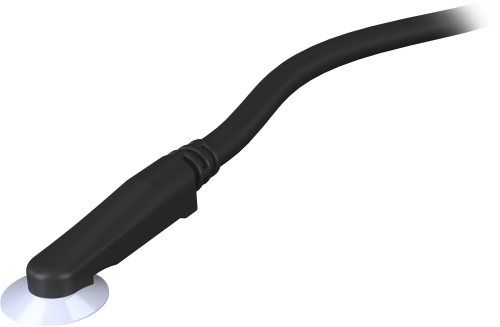This product is not available for new orders. We recommend ordering: CS241.

| Services Available |
|---|
Resumen
El sensor de temperatura de superficie CS240 está basado en un sensor PT1000 Clase A RTD, incrustado dentro de un bloque compacto rugerizado ideal para uso en aplicaciones fotovoltaicas donde haya que medir con un alto nivel de precisión la temperatura de la parte trasera de una placa solar. Para aguantar las duras condiciones de trabajo, la PT1000 se aloja dentro de un disco de aluminio autoadhesivo con un diseño especial.
Leer másVentajas y características
- Elemento sensor de precisión PT1000 Class A
- Cumple con IEC 60751, DIN EN 60751 (según IEC 751)
- Disponible con distintas longitudes de cable
- Diseño robusto para uso en duras condiciones
- Autoadhesivo con fácil montaje y larga duración
- Configuraciones a 2-hilos y 4-hilos según disponibilidad de canales y precisión requerida
- Conexión rápida del cabezal del sensor, que facilita la instalación y sustitución
- Trazabilidad NIST con la opción de compra calibración de temperatura en 3 puntos
Imágenes










Descripción detallada
The CS240 consists of a Pt-1000 class A PRT encased in an aluminum disk. The disk protects the PRT, particularly during installation when pulled through conduit, and promotes heat transfer from the surface. An adhesive tab on the disk fastens the CS240 to the measurement surface. If the temperature may exceed 70°C, Extreme sealing tape is also required to secure the probe.
The CS240 provides PV stakeholders with highly accurate back-of-module temperature, even at long cable lengths, for use in power performance modeling and simulation of solar energy applications. Back-of-module temperature is critical for any evaluation of effective irradiance and power conversion.
Preguntas frecuentes
Número de FAQs relacionadas con CS240: 3
Expandir todoDesplegar todo
-
A hot spot is caused if a cell in series is under-producing due to shading and gets reversed bias due to the other producing cells. For bifacial modules, as long as the front face is not shaded, all the cells should be producing and covering a small area on the back side and should not cause a severe mismatch.
-
NIST traceability provides an assurance of accuracy. This is especially desirable in accordance with IEC 61724, which is a solar energy generation monitoring specification that requires calibrated sensors.
-
Even when three-pt calibration isn’t ordered, when we build the probes, we perform a final test to verify that they are reading within 0.3°C of our calibrated reference sensor at room temperature.
Especificaciones
| Sensor | 1000 Ω DIN Class A RTD |
| Measurement Description | Back-of-module temperature |
| Operating Temperature Range | -40° to +135°C |
| Cable Temperature Rating | 105°C |
| Class A PRT Accuracy | ± (0.15 + 0.002T) |
| Temperature Coefficient | TCR = 3850 ppm/K |
| Element Type | Precision 1000 ohm Class A platinum sensing element (Pt-1000) |
| Long-Term Stability | Maximum Ro drift 0.04% (after 1000 h at 400°C) |
| Measuring Current | 0.1 to 0.3 mA |
| Disk Material | Anodized aluminum |
| Cable Jacket Material | Black semi-gloss PVC, UL VW-1 sunlight-resistant for outdoor use |
| Sensitivity | ±0.06 Ω or ±0.15°C |
| Disk Diameter | 2.54 cm (1.0 in.) |
| Overall Probe Length | 6.35 cm (2.5 in.) |
| Overmolded Joint Dimensions | 5.72 x 1.12 x 1.47 cm (2.25 x 0.44 x 0.58 in.) |
| Weight | 90.7 g with 3.2 m cable (0.2 lb with 10.5 ft cable) |
Conductors |
|
| Wire Size and Type | 24 AWG (7/32) tinned copper |
| Insulation Type | PVC |
| UL | AWM 10012 1000V 105°C |
| Filler | Fibrillated polypropylene as required for uniform round construction |
| Drain | 24 AWG (7/32) tinned copper (cabled, touching foil) |
| Shield | Aluminum/Mylar (100% coverage, 25% minimum overlap, foil facing in) |
| Nominal Wire Diameter | 0.61 mm (0.024 in.) |
Compliance |
|
| -NOTE- | Compliance information can be found in the Documents section of the web page. |
| Approvals | UL AWM 2586 1000V 105°C; CSA AWM 600V 105°C FT |
| EMC Compliance | Conforms with Electromagnetic Compatibility Directive (EMC). |
| RoHS2 | Conforms with the Restriction of Hazardous Substances Directive (RoHS2). |


